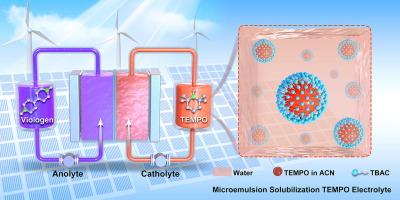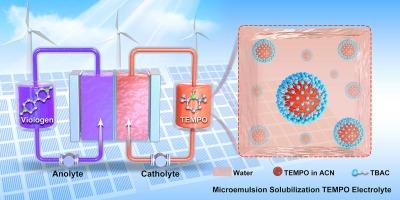TEMPO 微乳液 在水性有机氧化还原液流电池中实现极高容量的电解质
IF 4.3
2区 工程技术
Q2 ENGINEERING, CHEMICAL
引用次数: 0
摘要
2,2,6,6-四甲基胡椒二氧基(TEMPO)的低水溶性严重限制了水相有机氧化还原液流电池(aorfb)的容量。本文提出了一种微乳液增溶策略来解决这一问题。通过对助溶剂和表面活性剂的筛选,在乙腈和四丁基氯化铵组成的微乳液中实现了3.45 M的高水溶性。理化表征表明,四丁基氯化铵的烷基链在有机相中被分割,实现了有机相和水相的融合和平衡,从而实现了优异的稳定性、良好的离子电导率和低粘度。采用2.5 M电解液的AORFB的容量为60.6 Ah L−1,是tempo型AORFB中实用容量最高的产品之一。这项工作表明,通过简单地调节电解溶液来实现aorfb的高容量是一种简单而通用的策略,这比复杂的分子工程策略更具优势。本文章由计算机程序翻译,如有差异,请以英文原文为准。


TEMPO microemulsion enabling extremely high capacity catholyte in aqueous organic redox flow batteries
The low aqueous solubility of 2,2,6,6-tetramethylpiperidinooxy (TEMPO) severely limits the capacity of aqueous organic redox flow batteries (AORFBs). Herein, a microemulsion solubilization strategy is developed to address this issue. By screening the co-solvent and the surfactant, a high aqueous solubility of 3.45 M is realized in the microemulsion consisting of acetonitrile and tetrabutylammonium chloride. Physicochemical characterizations reveal that the alkyl chains of tetrabutylammonium chloride are partitioned in the organic phase to realize the fusion and equilibrium of the organic and water phases, which realizes a superior stability, decent ionic conductivity and low viscosity. The AORFB fed with the 2.5 M electrolyte shows a capacity of 60.6 Ah L−1, which is one of the highest practical capacities among TEMPO-based AORFBs. This work manifests a facile and universal strategy by simply regulating the electrolytic solution to realize a high capacity in AORFBs, which shows advantages over the complicated molecule engineering strategy.
求助全文
通过发布文献求助,成功后即可免费获取论文全文。
去求助
来源期刊

Chemical Engineering Science
工程技术-工程:化工
CiteScore
7.50
自引率
8.50%
发文量
1025
审稿时长
50 days
期刊介绍:
Chemical engineering enables the transformation of natural resources and energy into useful products for society. It draws on and applies natural sciences, mathematics and economics, and has developed fundamental engineering science that underpins the discipline.
Chemical Engineering Science (CES) has been publishing papers on the fundamentals of chemical engineering since 1951. CES is the platform where the most significant advances in the discipline have ever since been published. Chemical Engineering Science has accompanied and sustained chemical engineering through its development into the vibrant and broad scientific discipline it is today.
 求助内容:
求助内容: 应助结果提醒方式:
应助结果提醒方式:


